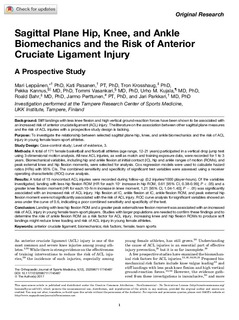| dc.contributor.author | Leppänen, Mari | |
| dc.contributor.author | Pasanen, Kati | |
| dc.contributor.author | Krosshaug, Tron | |
| dc.contributor.author | Kannus, Pekka | |
| dc.contributor.author | Vasankari, Tommi | |
| dc.contributor.author | Kujala, Urho M | |
| dc.contributor.author | Bahr, Roald | |
| dc.contributor.author | Perttunen, Jarmo | |
| dc.contributor.author | Parkkari, Jari | |
| dc.date.accessioned | 2018-04-30T11:06:15Z | |
| dc.date.available | 2018-04-30T11:06:15Z | |
| dc.date.created | 2018-01-12T14:14:51Z | |
| dc.date.issued | 2017 | |
| dc.identifier.citation | The Orthopaedic Journal of Sports Medicine. 2017, 5, 2325967117745487. | nb_NO |
| dc.identifier.issn | 2325-9671 | |
| dc.identifier.uri | http://hdl.handle.net/11250/2496522 | |
| dc.description | This open-access article is published and distributed under the Creative Commons Attribution - NonCommercial - No Derivatives License (http://creativecommons.org/licenses/by-nc-nd/4.0/), which permits the noncommercial use, distribution, and reproduction of the article in any medium, provided the original author and source are credited. You may not alter, transform, or build upon this article without the permission of the Author(s). For reprints and permission queries, please visit SAGE’s website at http://www.sagepub.com/journalsPermissions.nav. | nb_NO |
| dc.description.abstract | Background: Stiff landings with less knee flexion and high vertical ground-reaction forces have been shown to be associated with an increased risk of anterior cruciate ligament (ACL) injury. The literature on the association between other sagittal plane measures and the risk of ACL injuries with a prospective study design is lacking. Purpose: To investigate the relationship between selected sagittal plane hip, knee, and ankle biomechanics and the risk of ACL injury in young female team-sport athletes. Study Design: Case-control study; Level of evidence, 3. Methods: A total of 171 female basketball and floorball athletes (age range, 12-21 years) participated in a vertical drop jump test using 3-dimensional motion analysis. All new ACL injuries, as well as match and training exposure data, were recorded for 1 to 3 years. Biomechanical variables, including hip and ankle flexion at initial contact (IC), hip and ankle ranges of motion (ROMs), and peak external knee and hip flexion moments, were selected for analysis. Cox regression models were used to calculate hazard ratios (HRs) with 95% CIs. The combined sensitivity and specificity of significant test variables were assessed using a receiver operating characteristic (ROC) curve analysis. Results: A total of 15 noncontact ACL injuries were recorded during follow-up (0.2 injuries/1000 player-hours). Of the variables investigated, landing with less hip flexion ROM (HR for each 10 increase in hip ROM, 0.61 [95% CI, 0.38-0.99]; P < .05) and a greater knee flexion moment (HR for each 10-Nm increase in knee moment, 1.21 [95% CI, 1.04-1.40]; P ¼ .01) was significantly associated with an increased risk of ACL injury. Hip flexion at IC, ankle flexion at IC, ankle flexion ROM, and peak external hip flexion moment were not significantly associated with the risk of ACL injury. ROC curve analysis for significant variables showed an area under the curve of 0.6, indicating a poor combined sensitivity and specificity of the test. Conclusion: Landing with less hip flexion ROM and a greater peak external knee flexion moment was associated with an increased risk of ACL injury in young female team-sport players. Studies with larger populations are needed to confirm these findings and to determine the role of ankle flexion ROM as a risk factor for ACL injury. Increasing knee and hip flexion ROMs to produce soft landings might reduce knee loading and risk of ACL injury in young female athletes. | nb_NO |
| dc.language.iso | eng | nb_NO |
| dc.subject | anterior cruciate ligament | nb_NO |
| dc.subject | biomechanics | nb_NO |
| dc.subject | risk factors | nb_NO |
| dc.subject | female | nb_NO |
| dc.subject | team sports | nb_NO |
| dc.title | Sagittal Plane Hip, Knee, and Ankle Biomechanics and the Risk of Anterior Cruciate Ligament Injury :A Prospective Study | nb_NO |
| dc.type | Journal article | nb_NO |
| dc.type | Peer reviewed | nb_NO |
| dc.description.version | publishedVersion | nb_NO |
| dc.rights.holder | © The Author(s) 2017 | nb_NO |
| dc.source.pagenumber | 2325967117745487 | nb_NO |
| dc.source.volume | 5 | nb_NO |
| dc.source.journal | The Orthopaedic Journal of Sports Medicine | nb_NO |
| dc.source.issue | 12 | nb_NO |
| dc.identifier.doi | 10.1177/2325967117745487 | |
| dc.identifier.cristin | 1541684 | |
| dc.description.localcode | Seksjon for idrettsmedisinske fag / Department of Sport Medicine | nb_NO |
| cristin.unitcode | 150,34,0,0 | |
| cristin.unitname | Seksjon for idrettsmedisinske fag | |
| cristin.ispublished | true | |
| cristin.fulltext | original | |
| cristin.qualitycode | 1 | |
